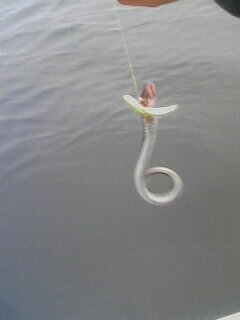snake7676
9/21/2008 7:21:00 AMSea Lamprey
Petromyzon marinus
Length: 12 to 20 inches
Weight: 8 to 13 ounces
Coloring: grey-blue back, metallic violet on sides, shading to silver-white underneath
Common Names: great sea lamprey, lake lamprey, lamprey, lamprey eel
Found in Lakes: Michigan, Huron, Ontario, Erie, and Superior
In their natural habitat, sea lamprey -- like salmon and alewives -- are ocean fish that spawn in fresh water. But some sea lamprey have always inhabited Lake Ontario and the St. Lawrence River, which are open to the Atlantic Ocean. In 1921, lampreys appeared in Lake Erie for the first time, arriving via the Welland Canal. From there, they rapidly colonized all of the upper Great Lakes, with especially large infestations developing in Lakes Michigan and Huron.
The sea lamprey is an agressive parasite -- equipped with a tooth-filled mouth that flares open at the end of its eel-like body.
When attacking, the lamprey fastens onto its prey and rasps out a hole with its rough tongue.
An anticoagulant in the lamprey's saliva keeps the wound open for hours or weeks, until the lamprey is satiated or the host fish dies.
In 1958, scientists finally found TFM -- a chemical that selectively kills sea lamprey larvae in their spawning streams -- and brought the lamprey under control. Lamprey numbers in Lake Michigan are currently only about 10 percent of their peak numbers in the 1950s. However, some biologists are concerned that these surviving populations might develop a resistance to the lampricide or, just as worrisome, an ability to spawn on the deltas at stream mouths -- deeper waters not suitable for lampricide treatment.
A more positive approach might be to harvest and market the lampreys. For centuries, river lampreys have been considered a delicacy in Europe -- King Henry I of England, in a fit of royal gluttony, is said to have died from a "surfeit of lamprey." But the unappetizing appearance of the eel-like fish and their unpalatable state when caught on their spawning runs has so far undermined their popularity as a food fish in this country.
